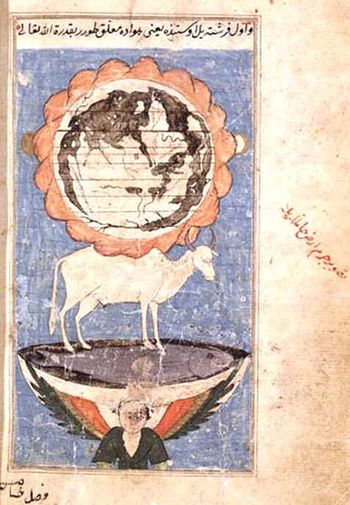「カフ山」の版間の差分
| 15行目: | 15行目: | ||
アラビア語で「カフ山」は、地球を取り囲む海の彼方にあることから「地の果て」と呼ばれる神秘的な山である<ref name="Qaf">[http://www.mythologydictionary.com/mount-qaf-mythology.html Mount Qaf - Mythology Dictionary](リンク切れ:22-05-09)</ref>。その遠さから、北極点はこの山と同じ、とされることもある<ref>Ibrahim Muhawi & Sharif Kanaana. ''Speak, Bird, Speak Again: Palestinian Arab Folktales.'' Berkeley University of California Press</ref><ref>Irgam Yigfagna; ''al-Jabal al-Lamma''</ref>。ハティム・タイの記述によると、カフ山は緑色のエメラルドやペリドット、クリソライトで構成され、その反射で空が緑色に染まっている、と言われている。カフ山はジン族の故郷であり、その先には目に見えない神の世界が始まるとされている。アラビアでは、カフ山はアッラーが地球を支えるために創った山脈の中で最も高く、他のすべての地上の山脈の親であり、その山脈は地下でつながっているとされる。この山脈は、既知の世界を取り囲む海によって、人間の世界と隔てられている。カフ山は原始の山として、自然と超自然が出会う宇宙の山を象徴するようになり、地上と天上の世界のつながりともみなされたのである。ここには、アンカと[[ロック鳥]]が来ると言われている。暗闇の中にあるエメラルドでできた都市ジャブルカとジャブルサは、カフ山に隣接していると言われている<ref name="Lebling"/><ref name="Qaf"/><ref name="wonders">Qazwīnī Zakarīyā Ibn-Muḥammad al- , Kosmographie: ¬Die Wunder der Schöpfung , 1849 , Dieterich , https://books.google.com/books?id=eCk-AAAAcAAJ&pg=PT152 , 3 October 2019</ref>。 | アラビア語で「カフ山」は、地球を取り囲む海の彼方にあることから「地の果て」と呼ばれる神秘的な山である<ref name="Qaf">[http://www.mythologydictionary.com/mount-qaf-mythology.html Mount Qaf - Mythology Dictionary](リンク切れ:22-05-09)</ref>。その遠さから、北極点はこの山と同じ、とされることもある<ref>Ibrahim Muhawi & Sharif Kanaana. ''Speak, Bird, Speak Again: Palestinian Arab Folktales.'' Berkeley University of California Press</ref><ref>Irgam Yigfagna; ''al-Jabal al-Lamma''</ref>。ハティム・タイの記述によると、カフ山は緑色のエメラルドやペリドット、クリソライトで構成され、その反射で空が緑色に染まっている、と言われている。カフ山はジン族の故郷であり、その先には目に見えない神の世界が始まるとされている。アラビアでは、カフ山はアッラーが地球を支えるために創った山脈の中で最も高く、他のすべての地上の山脈の親であり、その山脈は地下でつながっているとされる。この山脈は、既知の世界を取り囲む海によって、人間の世界と隔てられている。カフ山は原始の山として、自然と超自然が出会う宇宙の山を象徴するようになり、地上と天上の世界のつながりともみなされたのである。ここには、アンカと[[ロック鳥]]が来ると言われている。暗闇の中にあるエメラルドでできた都市ジャブルカとジャブルサは、カフ山に隣接していると言われている<ref name="Lebling"/><ref name="Qaf"/><ref name="wonders">Qazwīnī Zakarīyā Ibn-Muḥammad al- , Kosmographie: ¬Die Wunder der Schöpfung , 1849 , Dieterich , https://books.google.com/books?id=eCk-AAAAcAAJ&pg=PT152 , 3 October 2019</ref>。 | ||
| − | ザカリーヤ・アル・カズウィーニーは13世紀に『被造物の驚異と万物の珍奇』を出版し<ref>[https://www.wdl.org/en/item/15264/ The Wonders of Creation - World Digital Library]</ref> | + | ザカリーヤ・アル・カズウィーニーは13世紀に『被造物の驚異と万物の珍奇』を出版し<ref>[https://www.wdl.org/en/item/15264/ The Wonders of Creation - World Digital Library]</ref>、近世のイスラーム社会に大きな影響を及ぼした。カズウィーニーの宇宙論によれば、空は地球に落ちないように神によって保たれている。 |
| 22行目: | 22行目: | ||
| − | + | The Earth is considered flat (later Islamic scholars believed that it was round) and surrounded by a series of mountains —including Mount Qaf— that hold it in its place like pegs; the Earth is supported by the [[Kujata|Kuyuthan]] that stands on [[Bahamut]], a giant fish ({{lang-ar|بهموت}} ''Bahamūt'') dwelling in a cosmic ocean; the ocean is inside a bowl that sits on top of an angel or [[jinn]].<ref>Zakariya al-Qazwini. ''ʿAjā'ib al-makhlūqāt wa gharā'ib al-mawjūdāt'' (The Wonders of Creation). Original published in 1553 AD</ref> | |
According to certain authors, the ''Jabal Qaf'' of [[Cosmology in medieval Islam|Muslim cosmology]] is a version of [[Rupes Nigra]], a mountain whose ascent —such as [[Dante Alighieri|Dante's]] climbing of the [[Purgatorio|Mountain of Purgatory]], represents the pilgrim's progress through spiritual states.<ref>Irgam Yigfagna; ''al-Jabal al-Lamma'', p. 44</ref> | According to certain authors, the ''Jabal Qaf'' of [[Cosmology in medieval Islam|Muslim cosmology]] is a version of [[Rupes Nigra]], a mountain whose ascent —such as [[Dante Alighieri|Dante's]] climbing of the [[Purgatorio|Mountain of Purgatory]], represents the pilgrim's progress through spiritual states.<ref>Irgam Yigfagna; ''al-Jabal al-Lamma'', p. 44</ref> | ||
2022年5月11日 (水) 01:02時点における版
Mount Qaf, or Qaf-Kuh, also spelled Cafcuh and Kafkuh (テンプレート:Lang-fa), or Jabal Qaf, also spelled Djebel Qaf (アラビア語:جبل ق カフ山(Mount Qaf)、またはカフ・ク(Qaf-KuhあるいはCafcuhあるいはKafkuh、ペルシア語: قافکوه)、またはジャバル・カフ(Jabal QafあるいはDjebel Qaf、アラビア語: Djebel Qaf)、またはコ・イ・カフ(Koh-i-QafあるいはKoh-QafあるいはKuh-i-QafあるいはKuh-e Qaf、ペルシア語: Koh-Qaf)、またはク・イ・カフ(ペルシア語: Kuh-e-Qaf)。جبل قاف)、またはKoh-i-Qaf、Kuh-i-QafまたはKuh-e Qaf( Persian: کوہ قاف)は、中東の俗信にある伝説上の山である。イスラム教の伝統では、カフ山はジンの故郷であり、神によって輝くエメラルドで作られたと言われている[2]。
イランの伝承
歴史上、イランの勢力は北コーカサス全域に及ぶことはなく、古代の言い伝えではこの高山は謎に包まれていた[3]。イランの伝承では、カフ山は以下のような特徴を持っていた。
カフ山のペリの王国とディヴの王国には、壮大な首都ユヘラバード(Juherabad)(宝石都市)を持つShad-u-kam(快楽と喜び)、アンバーラバード(Amberabad)(琥珀都市)、アヘルマナーバード(Ahermanabad)が含まれる[2]。
アラビアの伝承
アラビア語で「カフ山」は、地球を取り囲む海の彼方にあることから「地の果て」と呼ばれる神秘的な山である[5]。その遠さから、北極点はこの山と同じ、とされることもある[6][7]。ハティム・タイの記述によると、カフ山は緑色のエメラルドやペリドット、クリソライトで構成され、その反射で空が緑色に染まっている、と言われている。カフ山はジン族の故郷であり、その先には目に見えない神の世界が始まるとされている。アラビアでは、カフ山はアッラーが地球を支えるために創った山脈の中で最も高く、他のすべての地上の山脈の親であり、その山脈は地下でつながっているとされる。この山脈は、既知の世界を取り囲む海によって、人間の世界と隔てられている。カフ山は原始の山として、自然と超自然が出会う宇宙の山を象徴するようになり、地上と天上の世界のつながりともみなされたのである。ここには、アンカとロック鳥が来ると言われている。暗闇の中にあるエメラルドでできた都市ジャブルカとジャブルサは、カフ山に隣接していると言われている[2][5][8]。
ザカリーヤ・アル・カズウィーニーは13世紀に『被造物の驚異と万物の珍奇』を出版し[9]、近世のイスラーム社会に大きな影響を及ぼした。カズウィーニーの宇宙論によれば、空は地球に落ちないように神によって保たれている。
The Earth is considered flat (later Islamic scholars believed that it was round) and surrounded by a series of mountains —including Mount Qaf— that hold it in its place like pegs; the Earth is supported by the Kuyuthan that stands on Bahamut, a giant fish (テンプレート:Lang-ar Bahamūt) dwelling in a cosmic ocean; the ocean is inside a bowl that sits on top of an angel or jinn.[10]
According to certain authors, the Jabal Qaf of Muslim cosmology is a version of Rupes Nigra, a mountain whose ascent —such as Dante's climbing of the Mountain of Purgatory, represents the pilgrim's progress through spiritual states.[11]
Sufi tradition
In some Sufistic oral traditions, as conceived by Abd al-Rahman and Attar, Mount Qaf was considered as a realm of consciousness and the goal of a murid. Hadda Sahib (d. 1903) is said to have visited Mount Qaf in one night and was greeted by the king of peris.[12]
In literature
Mount Qaf (original Turkish title Kafdağı) is also the title of a novel by Turkish author Müge İplikçi.
Mount Qaf is frequently referenced in the 1001 Nights as a home of jinn.
関連項目
Further reading
- Daniel G. Prior: Travels of Mount Qāf: From Legend to 42° 0' N 79° 51' E. in: Oriente Moderno, Nuova serie, Anno 89, Nr. 2. (Studies on Islamic Legends) 2009, pp. 425–444
参考文献
- Wikipedia:Mount Qaf
参照
- ↑ 1203-1283。ペルシア人の法学者、宇宙構造論学者、地理学者。
- ↑ 2.0 2.1 2.2 2.3 https://books.google.com/books?id=qKL3AgAAQBAJ , Legends of the Fire Spirits: Jinn and Genies from Arabia to Zanzibar, Lebling, Robert, I.B.Tauris, isbn:9780857730633, pages24-28
- ↑ كوه قاف در اسطوره و عرفان ايراني , https://web.archive.org/web/20090219041846/http://naghashi.blogfa.com/post-43.aspx , 2009-02-19
- ↑ カフ(Qāf)は、中世ペルシャ語で「不明」を意味する「gâp」がアラビア語化したものである。ガプク(Gapkuh)または未知の山についての最古の記述は、シャプール1世(AD241-272)の黒海とカスピ海の間の山々についての碑文である。コーカサス山脈の名前は、最終的にガプク(Gapkuh)の変種であるKapkofまたはKafkazから来ていると言われている。
- ↑ 5.0 5.1 Mount Qaf - Mythology Dictionary(リンク切れ:22-05-09)
- ↑ Ibrahim Muhawi & Sharif Kanaana. Speak, Bird, Speak Again: Palestinian Arab Folktales. Berkeley University of California Press
- ↑ Irgam Yigfagna; al-Jabal al-Lamma
- ↑ Qazwīnī Zakarīyā Ibn-Muḥammad al- , Kosmographie: ¬Die Wunder der Schöpfung , 1849 , Dieterich , https://books.google.com/books?id=eCk-AAAAcAAJ&pg=PT152 , 3 October 2019
- ↑ The Wonders of Creation - World Digital Library
- ↑ Zakariya al-Qazwini. ʿAjā'ib al-makhlūqāt wa gharā'ib al-mawjūdāt (The Wonders of Creation). Original published in 1553 AD
- ↑ Irgam Yigfagna; al-Jabal al-Lamma, p. 44
- ↑ PRIOR, DANIEL G. “TRAVELS OF MOUNT QĀF: FROM LEGEND TO 42° 0' N 79° 51' E.” Oriente Moderno, vol. 89, no. 2, 2009, pp. 425–444. JSTOR, www.jstor.org/stable/25818227. Accessed 18 Mar. 2020.
